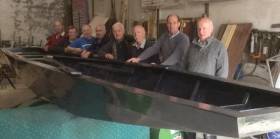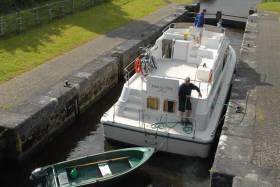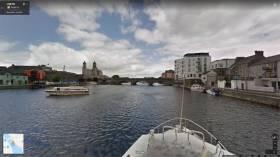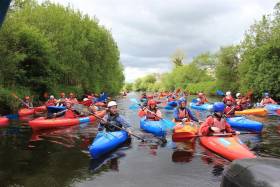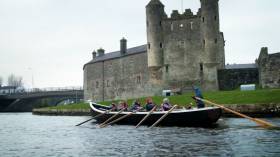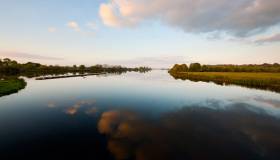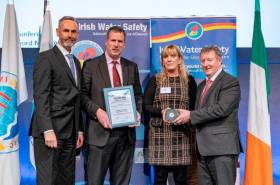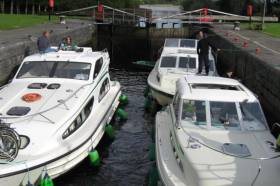Displaying items by tag: inland waters
Warning Over Low Water Levels For Navigation On Royal Canal
#RoyalCanal - Waterways Ireland is advising masters and users of the Royal Canal that due to unprecedented dry weather conditions and low rainfall levels and subsequent low levels in Lough Owel, navigation water levels cannot be guaranteed on certain sections of the canal, particularly the summit level and adjacent levels.
Masters should contact the local water patroller prior to any planned journey along this inland waterway.
Lough Erne Heritage Wins UK National Lottery Support For Programme To Preserve Area’s Boat Building History
A new community heritage project in Co Fermanagh focuses on raising awareness and preserving the heritage of traditional boat building and the cultural heritage of the people who lived on and around the shores of Lough Erne.
The ERNE Programme, which runs until June 2020, has been made possible by a UK National Lottery Heritage Fund award of £56,400 thanks to the money raised by lottery players.
This funding will help the programme establish a network of groups around Lough Erne, offer training opportunities for local volunteers to learn new skills, and develop a website with a ‘virtual museum’,
Other initiatives include interactive educational materials for schools, hosting Heritage in Action rowing regattas and an exhibition in June 2020 to showcase the heritage from around the inland waterway.
Welcoming the funding award, Gabriel Fitzpatrick, Lough Erne Heritage chair, said: “This project will enable local people to explore and share local history. We are pleased to have the opportunity to bring people together and tell the story.”
Jim McGreevy, of The National Lottery Heritage Fund’s NI committee, added: “We feel this project focusing on the strong boat building, rowing and associated heritage will complement our significant investment into the Lough Erne Landscape Partnership project.
“We’ve just launched our new five-year funding framework which outlines how we will continue to inspire, lead and resource the heritage sector.
“This new project is a great example of the projects we want to fund, it plans to explore important local heritage, involve a wider range of people in the project and to share everything that they uncover. We wish the project team well as they embark on their project.”
Formed in 2015, Lough Erne Heritage encourages research about Lough Erne, its traditional boats and the people who built and used them. In 2016, together with Cavan Town Men’s Shed, Lough Erne Heritage built two traditional Lough Erne Cots in order to demonstrate how they would have been used.
Boost To Waterways Ireland Capital Funding In 2019: Minister
#InlandWaters - Funding for Waterways Ireland is on the rise, and particularly for projects in the Dublin region, according to Heritage Minister Josepha Madigan.
Responding last week to a Dáil question from Cavan-Monaghan TD Brendan Smith, Minister Madigan outlined that estimates for 2019 provide for an allocation of €25,117,000 for Waterways Ireland, representing an overall increase of €1 million on last year’s original allocation.
Within this figure, capital funding for Waterways Ireland has been increased by €800,000 from €3,580,00 to €4,380,000 in 2019.
In response to Dublin West TD Joan Burton, through whose constituency the Royal Canal flows, Minister Madigan provided a breakdown of Waterways Ireland’s Exchequer (current and capital) funding allocation from 2016 to present.
The level of funding provided for maintenance and upgrade of waterways, canals and rivers in Co Dublin specifically as been forecast at €3,153,665 for 2019 — compared to €1,158,136 in 2018.
Responding to a follow-up question from Deputy Smith regarding specific capital funding for maintenance and improvement works on the Shannon-Erne Waterway, Minister Madigan outlined that Waterways Ireland plans to complete 10.4km of Greenway enhancement towpath as well as advance plans for a full-scale Greenway along the 64km route.
Capital funding allocated for Shannon-Erne works is €125,000 for 2019, and Waterways Ireland is partnered with local authorities for three projects to the tuned of €311,500:
- Development of a Blueway trail between Leitrim Village and Kilclare with Leitrim County Council (€162,000 WI contribution).
- Development of a Blueway trail between Ballyconnell and Bellaheady Bridge with Cavan County Council (€124,500).
- Development of forward planning for a trail extension from Aghalane to Lock 1 at Corraquill with Cavan County Council (€25,000).
The minister underlined that any requests for additional funding from Waterways Ireland in 2019 “can only be considered on their merits, taking into account the organisation’s strategic business objectives for the waterways network and the estimates and annual budgetary processes.”
Previously, Kildare South TD Fiona O’Loughlin asked the minister the extent to which she expects an amicable resolution to issues between Waterways Ireland and traditional dwellers and recreational users of the Grand Canal in Co Kildare.
Minister Madigan replied that Waterways Ireland “continues to concentrate on boats which consistently remain in breach of the bye-laws”, and that the cross-border body “will consult with its stakeholders in the drafting of additional bye-laws to ensure proper regulation of craft on the waterways” following the signing into law last summer of the Heritage Act 2018.
‘Green & Silver’ Canal Rally In Works For Summer 2019
The Dublin branch of the Inland Waterways Association of Ireland is working on plans for a rally this summer inspired by the Green & Silver route.
2019 marks the 70th anniversary of the publication of Green & Silver by LTC Rolt, a book which recounted an influential voyage in 1946 from the Shannon to Dublin along the Grand Canal, then back to the Shannon via the Royal Canal, including a turn north to Lough Key and south again to Lough Derg.
The 356km inland waterways route has since become known as the ‘Green & Silver Challenge’ and has been championed by IWAI Dublin since the full navigation of the Royal Canal was reopened in 2010.
Now the Dublin branch is looking to encourage as many boats as possible to join the rally from this May “to show the canals are being used and not just a pretty water feature”.
A provisional date for boats heading to Dublin on the Royal Canal to meet at the 12th Lock in Castleknock has been set for Friday 3 May, with boats on the reverse route along the Grand Canal to meet at Lucan’s 12th lock on Friday 10 May.
Boats would converge on the River Liffey for a two-day rally on the weekend of 18-19 May, with boats heading out on the Grand Canal the following weekend (25-26 May) and on the Royal Canal the week after that (1-2 June).
Prizes are being commissioned for boats that have completed the trip several times, with more on this and confirmed dates for the rally to come from IWAI Dublin in the coming weeks.
Explore The River Shannon Virtually Via Google Maps
Planning an inland waterways cruise this spring or summer? Or simply curious to explore the wonders of Ireland’s longest river from anywhere in the world?
Now you can visit the River Shannon virtually thanks to the new boaters-eye view on Google Maps.
As previously reported on Afloat.ie, ‘river view’ images from this past summer’s Google Trekker survey of the River Shannon went live on Google Maps in December.
In conjunction with Waterways Ireland, the Google Trekker Loan Programme toured from Lough Allen to Loop Head gathering data for what amounts to “the first such water-based collection of imagery on the island of Ireland”.
Waterways Ireland pitches the project as “an invaluable tool in terms of promoting the Shannon Navigation as a destination for recreation, tourism, mindfulness, education and heritage appreciation, encouraging visitors to the area”.
But it will also be of use to communities along the waterway “to highlight this heritage asset and foster as sense of place”.
The Google Trekker footage of the Shannon River is now live on Google Maps and can be viewed via the ‘Street View’ function.
Applications Now Open For Waterways Ireland’s 2019 Events Programme
#InlandWaters - The Waterways Ireland Events Programme is now open for 2019 and welcomes applications from inland waterways and waterside communities seeking support to start and grow sustainable events.
Taking place annually for the past 13 years, the programme has supported competitions, learning experiences, community, historical and educational events for people with and without disabilities across thousands of communities nationwide.
Involving angling, canoeing, rowing, sailing and power sports, arts, history, drama and learning new skills, these events have most importantly been about having fun on the waterways under the auspices of Waterways Ireland, the recreation and navigation authority for the Barrow Navigation, Erne System, Grand Canal, Lower Bann Navigation, Royal Canal, Shannon-Erne Waterway and the Shannon Navigation.
“The new vision for the event programme will activate event organisers to consider how they can build in ongoing activity and sustained use of the waterways corridors into their event,” says Sharon Lavin, head of marketing and communications with Waterways Ireland.
“Tourism and participation in recreation has a social and economic impact in waterfront communities, and events are a great way to engage communities with previously under-utilised waterways.”
The application form and guidance notes can be viewed and completed online. Terms and conditions apply. The closing date the receipt of completed applications is Wednesday 16 January.
Waterways Ireland Shares Video ‘Stories From The Waterways’
Waterways Ireland’s YouTube channel is this week featuring a series of ‘Stories from the Waterways’ highlighting various community groups and cottage industries that have made the most of their local environment close to Ireland’s canals, lakes and rivers.
The first short film brings to life the work of Row the Erne, a group of experienced and novice rowers that meets every Saturday to row a traditional curragh built by the community themselves.
In Pollagh, Co Ofally, the Devery family tell the story of how the Grand Canal spurred the development of a brick-making industry, the skills from which survive to this day.
In Co Meath, the Ribbontail Padders comprises a group of families who took over an old lockkeeper’s cottage as a base from which to provide canoeing lessons on the Royal Canal.
And on the Lower Bann, joiner Bradden Braillie of the Portna Workshop talks through some of the vital work required to maintain the infrastructure of Ireland’s inland waterways, especially when dealing with technology such as original lock gates that could be hundreds of years old.
For a different perspective of the waterways, ‘river view’ images from this past summer’s Google Trekker survey of the River Shannon is now live on Google Maps.
In conjunction with Waterways Ireland, the Google Trekker Loan Programme toured from Lough Allen to Loop Head gathering data for what amounts to “the first such water-based collection of imagery on the island of Ireland”.
#InlandWaters - Waterways Ireland advises that the electricity supply to power pedestals and the supply of water to taps on public moorings on the Shannon Navigation will soon be disconnected for the winter period.
The move is being made for environmental reasons and to reduce maintenance costs. Services will be restored prior to the commencement of the 2019 boating season.
Shore power supply at the Round ‘O’ and Carrybridge public moorings on the Erne System, as well was water supply to taps throughout that system, was already disconnected or winter as of Wednesday 7 November.
IWAI Receives National Irish Water Safety Award
The Inland Waterways Association of Ireland (IWAI) was honoured this week at the Irish Water Safety National Awards.
The Community and Social Responsibility Award was in recognition of the work by the association and its members in supporting Irish Water Safety’s community work and water safety in general on Ireland’s inland waterways.
The award was presented at Dublin Castle on Thursday 29 November by Seán Canney, Minister of State at the Department of Rural & Community Development.
IWAI president John Dolan, speaking after the presentation, noted that it was a great honour for him and honorary secretary Kay Baxter to receive such an award on behalf of all IWAI members both past and present for their work in this area.
Dolan also stated that he felt privileged and humbled to be present with so many other voluntary organisations, individuals and members of the rescue and security services who have given so much.
That includes those receiving Long-Service Volunteer Awards for teaching swimming, water rescue and survival skills in communities nationwide, and the rescuers who received recognition with the Just in Time Rescue Award in appreciation for saving so many lives in the past year. Irish Sailing also received an award for its support of Irish Water Safety's communuty work.
Echoing the minister’s speech at the awards, the IWAI agrees that it only takes seconds for tragedy to strike and this can so easily be avoided if people learn about the hazards and take responsibility for their own safety, including wearing lifejackets when on or near the water.
The IWAI is a voluntary body representing over 3,500 enthusiasts, with 23 branches across the island of Ireland.
Waterways Ireland Website Launches New Corporate Social Media
#InlandWaters - This week Waterways Ireland has launched new corporate pages on Facebook and Twitter.
The social media accounts draw together all the messages around marine notices, job vacancies, construction works, corporate events and public consultations into a single location where interested parties can more easily find the information they need.
Waterways Ireland Notifications is the page name for both Facebook and Twitter.
All the posts will link back to the Waterways Ireland website where further detail, application forms, and options to participate will be more fully explained.
The current Waterways Ireland Facebook and Twitter pages “will continue to promote the enjoyment, scenic beauty, leisure travel and activities that form the pre-eminent experiences that bring waterway communities to life,” the cross-border agency says.




























